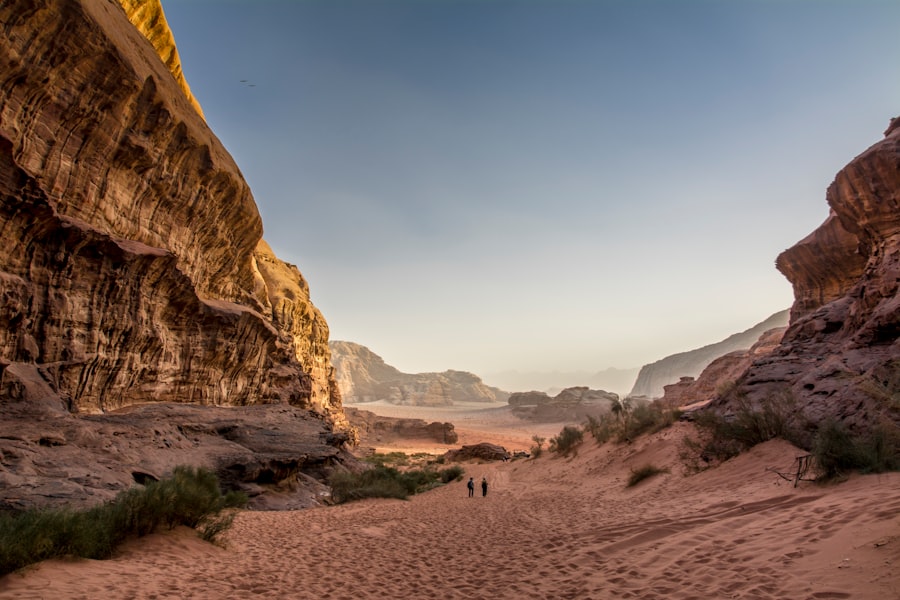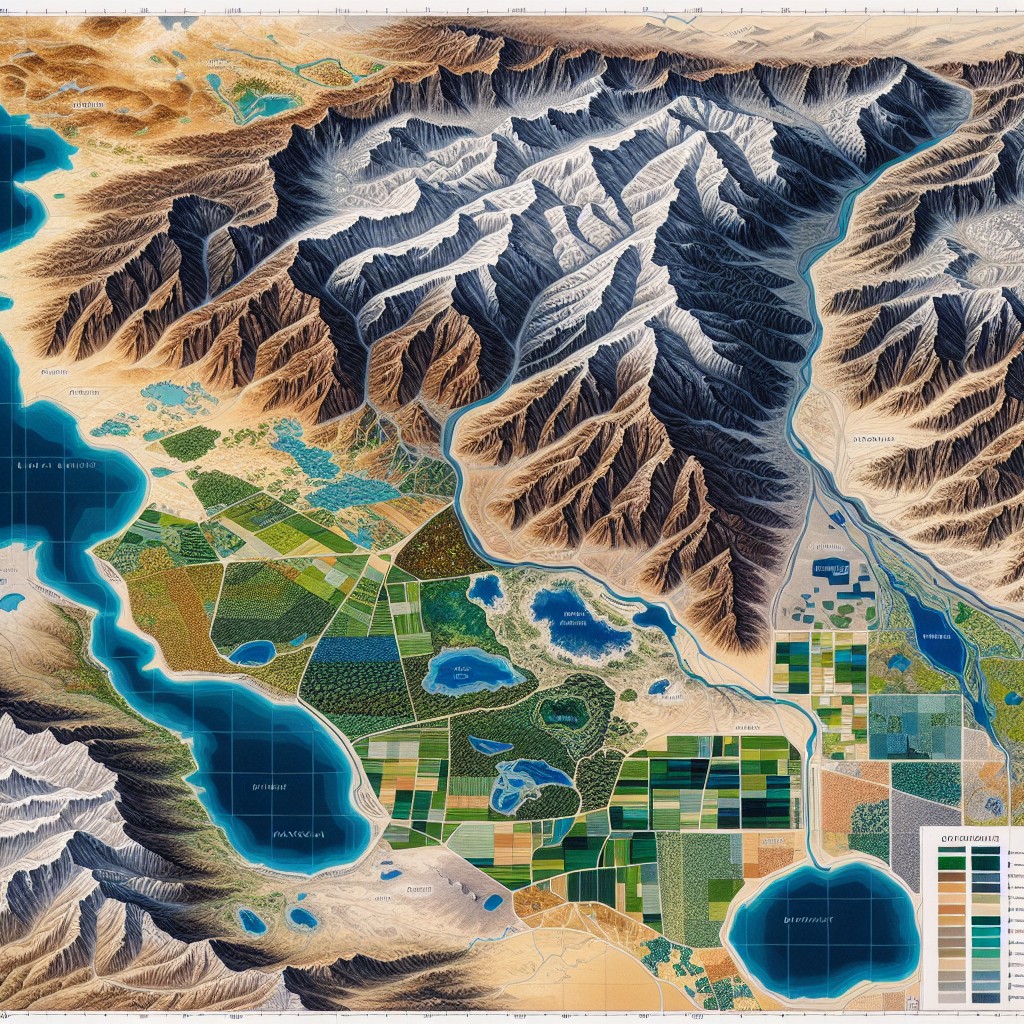Jordan, located in the heart of the Middle East, is a country that is rich in history and culture. It is bordered by Saudi Arabia to the south, Iraq to the east, Syria to the north, and Israel and Palestine to the west. With its strategic location, Jordan has been a crossroads of civilizations for thousands of years, resulting in a diverse and fascinating cultural heritage.
The history of Jordan dates back to ancient times, with evidence of human habitation dating back to the Paleolithic period. Throughout its history, Jordan has been home to numerous civilizations, including the Nabataeans, Romans, Byzantines, and Ottomans. This rich history is evident in the country’s archaeological sites, such as Petra and Jerash, which attract visitors from around the world.
In addition to its historical significance, Jordan is also known for its vibrant culture. The country is home to a diverse population, with Arab Bedouin tribes making up a significant portion of the population. The traditional Bedouin way of life can still be seen in many parts of Jordan, particularly in the desert regions.
Jordan is also known for its warm hospitality and friendly people. Visitors to the country are often struck by the genuine kindness and generosity of the Jordanian people. This hospitality is deeply rooted in Jordanian culture and is a reflection of the country’s values and traditions.
Summary
- Jordan is a country with a rich history and culture.
- Petra is a UNESCO World Heritage Site and a must-visit destination in Jordan.
- Wadi Rum is a natural wonder with stunning desert landscapes.
- The Dead Sea is a unique natural phenomenon and a popular health destination.
- Jordan’s culinary traditions are a fusion of flavours and cultures.
Discovering the Ancient City of Petra: A UNESCO World Heritage Site
One of Jordan’s most famous attractions is the ancient city of Petra. Known as the “Rose City” due to the color of its stone, Petra is a UNESCO World Heritage Site and one of the New Seven Wonders of the World. It was once a thriving trading hub and capital of the Nabataean Kingdom.
Petra’s history dates back to around 312 BC when it was established as the capital of the Nabataean Kingdom. The city flourished under Nabataean rule, with its strategic location along ancient trade routes bringing wealth and prosperity. However, Petra was eventually abandoned and forgotten by the outside world until it was rediscovered in the early 19th century.
Today, Petra is a must-visit destination for history and architecture enthusiasts. The city is famous for its impressive rock-cut architecture, with buildings carved directly into the sandstone cliffs. The most iconic structure in Petra is the Treasury, which is carved into a towering cliff face and is often featured in photographs of the city.
In addition to the Treasury, there are many other must-see attractions in Petra. The Monastery, High Place of Sacrifice, and Royal Tombs are just a few examples of the stunning architectural wonders that can be found in the city. Visitors can also explore the narrow siq, a winding canyon that leads to the heart of Petra.
When visiting Petra, it is important to come prepared. The site is quite large, so comfortable walking shoes are a must. It is also advisable to bring plenty of water and sunscreen, as the desert heat can be intense. Hiring a local guide is highly recommended, as they can provide valuable insights into the history and significance of the site.
Exploring the Desert Landscapes of Wadi Rum: A Natural Wonder
Located in southern Jordan, Wadi Rum is a desert landscape that is often referred to as the “Valley of the Moon.” This stunning natural wonder is characterized by its towering sandstone cliffs, red sand dunes, and vast open spaces. It has been inhabited by various civilizations throughout history and has served as a backdrop for numerous films, including Lawrence of Arabia.
Wadi Rum’s unique geography and history make it an ideal destination for outdoor enthusiasts. The desert offers a wide range of activities, including hiking, rock climbing, camel trekking, and jeep tours. Visitors can explore the desert on foot or by camel, taking in the breathtaking scenery and experiencing the tranquility of the desert.
One of the highlights of a visit to Wadi Rum is spending a night under the stars. The desert is known for its clear skies and lack of light pollution, making it an ideal location for stargazing. Many campsites in Wadi Rum offer overnight stays in traditional Bedouin-style tents, allowing visitors to experience the Bedouin way of life.
The best time to visit Wadi Rum is during the spring and autumn months when the weather is mild. Summers in Wadi Rum can be extremely hot, with temperatures reaching over 40 degrees Celsius. Winter can also be cold, with temperatures dropping below freezing at night. It is advisable to check the weather forecast before visiting and to come prepared with appropriate clothing.
The Dead Sea: A Unique Natural Phenomenon and Health Destination
| Metrics | Values |
|---|---|
| Location | Between Jordan and Israel |
| Surface Area | 605 km² |
| Depth | 304 m |
| Salt Concentration | 34.2% |
| Lowest Point on Earth | -429 m |
| Mineral Content | Potassium, Magnesium, Calcium, Bromine |
| Health Benefits | Relief from skin conditions, respiratory problems, and joint pain |
| Tourism | 1.5 million visitors annually |
The Dead Sea, located on the border between Jordan and Israel, is a unique natural phenomenon that attracts visitors from around the world. It is known for its high salt content, which makes it impossible for swimmers to sink. In fact, it is one of the saltiest bodies of water in the world.
The high salt content of the Dead Sea has numerous health benefits. The minerals found in the water and mud are believed to have therapeutic properties that can help with various skin conditions, such as psoriasis and eczema. Many visitors come to the Dead Sea specifically for its healing properties and take part in mud baths and salt scrubs.
In addition to its health benefits, the Dead Sea is also a popular destination for relaxation and recreation. The buoyancy of the water makes it easy to float effortlessly, providing a unique and relaxing experience. Visitors can also enjoy sunbathing on the shores of the Dead Sea or indulging in spa treatments at one of the many resorts in the area.
There are also several activities to do at the Dead Sea. One of the most popular is taking a dip in the mud pools and covering oneself in the mineral-rich mud. The mud is believed to have exfoliating and detoxifying properties, leaving the skin feeling soft and rejuvenated. Visitors can also take a boat ride on the Dead Sea or visit nearby attractions such as the ancient fortress of Masada.
Jordan’s Rich Culinary Traditions: A Fusion of Flavours and Cultures
Jordanian cuisine is a reflection of the country’s rich history and cultural diversity. It is a fusion of flavours and influences from the Arab, Mediterranean, and Levantine regions. Traditional Jordanian dishes are known for their bold flavours, aromatic spices, and use of fresh ingredients.
One of the most popular dishes in Jordan is mansaf, which is considered the national dish. Mansaf is a traditional Bedouin dish made with lamb cooked in a fermented yogurt sauce called jameed. It is typically served with rice and garnished with almonds and pine nuts. Mansaf is often enjoyed during special occasions and celebrations.
Another popular dish in Jordan is falafel, which is made from ground chickpeas or fava beans mixed with herbs and spices. The mixture is shaped into balls or patties and deep-fried until crispy. Falafel is typically served in pita bread with tahini sauce, salad, and pickles.
Makloubeh is another traditional Jordanian dish that is worth trying. It is a one-pot dish made with rice, meat (usually chicken or lamb), and a variety of vegetables such as eggplant, cauliflower, and carrots. The ingredients are layered in a pot and cooked together until tender. Makloubeh is often served upside down, with the rice on top and the meat and vegetables on the bottom.
When it comes to dining in Jordan, there are many excellent restaurants to choose from. In Amman, the capital city, there are numerous restaurants that offer a wide range of cuisines, from traditional Jordanian dishes to international fare. The Rainbow Street area is particularly popular for its vibrant food scene, with a variety of restaurants and cafes to suit all tastes.
The Legacy of the Nabataean Kingdom: A Journey Through Time

The Nabataean Kingdom was an ancient Arab civilization that existed from the 4th century BC to the 1st century AD. The kingdom was centered in what is now modern-day Jordan and was known for its advanced architecture and engineering skills. The Nabataeans were skilled traders and controlled important trade routes, which brought wealth and prosperity to their kingdom.
The most famous legacy of the Nabataean Kingdom is the ancient city of Petra. Petra was the capital of the Nabataean Kingdom and served as a major trading hub. The city was carved into the sandstone cliffs and was hidden from the outside world for centuries until it was rediscovered in the early 19th century.
In addition to Petra, there are several other Nabataean sites to visit in Jordan. One of these is the ancient city of Jerash, which was also an important center of trade during the Nabataean period. Jerash is known for its well-preserved Roman ruins, including a large amphitheater, temples, and colonnaded streets.
Another notable Nabataean site is Al-Khazneh, also known as the Treasury. This iconic structure is one of the most famous landmarks in Petra and is believed to have been a mausoleum for a Nabataean king. The Treasury is carved into a towering cliff face and is adorned with intricate carvings and sculptures.
The legacy of the Nabataean Kingdom is an important part of Jordanian culture and heritage. The Nabataeans were skilled craftsmen and their architectural achievements continue to inspire awe and admiration to this day. The kingdom’s influence can be seen in the architecture and design of many buildings in Jordan, as well as in the country’s cultural traditions.
The Roman Ruins of Jerash: A Testament to Jordan’s Diverse History
Located just north of Amman, the capital city, Jerash is home to some of the best-preserved Roman ruins in the world. The city was once a thriving Roman provincial capital and is now one of Jordan’s most popular tourist attractions. It offers a fascinating glimpse into the country’s diverse history and cultural heritage.
The history of Jerash dates back to the 4th century BC when it was founded by the Seleucid Empire. However, it was during the Roman period that Jerash reached its peak, becoming an important center of trade and commerce. The city was known for its impressive architecture, including a large amphitheater, temples, and colonnaded streets.
Today, visitors to Jerash can explore the well-preserved ruins and imagine what life was like during the Roman period. The city’s most famous attraction is the Oval Plaza, a large open space surrounded by columns and adorned with statues and fountains. The South Theater is another must-see attraction, with its well-preserved seating area and stunning views of the surrounding countryside.
In addition to its Roman ruins, Jerash is also known for its annual Jerash Festival, which takes place in July. The festival showcases traditional music, dance, and theater performances from Jordan and around the world. It is a celebration of Jordanian culture and heritage and attracts visitors from far and wide.
The Roman ruins of Jerash are an important part of Jordanian culture and serve as a testament to the country’s diverse history. They are a reminder of the rich cultural heritage that has shaped Jordan into the country it is today.
The Beauty of Jordan’s Natural Reserves: A Haven for Wildlife and Adventure
Jordan is home to several natural reserves that are a haven for wildlife and adventure enthusiasts. These reserves protect the country’s unique ecosystems and offer visitors the opportunity to explore its diverse landscapes, from desert plains to lush forests.
One of the most famous natural reserves in Jordan is the Dana Biosphere Reserve. Located in the southern part of the country, Dana is the largest nature reserve in Jordan and is home to a wide variety of plant and animal species. Visitors to Dana can enjoy hiking trails that take them through stunning landscapes, including deep canyons, sandstone cliffs, and fertile valleys.
Another popular natural reserve in Jordan is the Ajloun Forest Reserve. Located in the Ajloun Highlands, the reserve is known for its dense forests of oak, pine, and pistachio trees. It is home to a variety of wildlife, including deer, foxes, and wild boars. Visitors to Ajloun can explore the reserve on foot or by bike, taking in the breathtaking views and enjoying the tranquility of nature.
The Wadi Mujib Nature Reserve is another must-visit destination for adventure seekers. Located along the eastern shore of the Dead Sea, Wadi Mujib is a deep canyon that offers a range of outdoor activities, including hiking, canyoning, and swimming. The reserve is known for its dramatic landscapes and stunning waterfalls.
Preserving Jordan’s natural reserves is of utmost importance to protect its unique ecosystems and biodiversity. These reserves not only provide a habitat for wildlife but also offer opportunities for sustainable tourism and economic development. It is important for visitors to respect the rules and regulations of the reserves and to leave no trace behind.
The Importance of Religious Sites in Jordan: A Reflection of its Cultural Diversity
Jordan is home to several religious sites that are of great importance to people of different faiths. These sites are a reflection of the country’s cultural diversity and serve as a testament to its long history of religious tolerance and coexistence.
One of the most important religious sites in Jordan is Mount Nebo. Located near the town of Madaba, Mount Nebo is believed to be the place where Moses saw the Promised Land before he died. The site offers stunning views of the Jordan Valley and the Dead Sea and is a popular pilgrimage destination for Christians.
Another significant religious site in Jordan is Bethany Beyond the Jordan. Located on the eastern bank of the Jordan River, Bethany Beyond the Jordan is believed to be the place where Jesus was baptized by John the Baptist. The site has been recognized as a UNESCO World Heritage Site and attracts pilgrims from around the world.
The city of Madaba is also home to several important religious sites, including the Church of St. George. The church is known for its famous mosaic map of Jerusalem and the Holy Land, which dates back to the 6th century AD. The map is considered one of the oldest surviving maps of the region and is a must-see for history and art enthusiasts.
Visiting these religious sites is not only a spiritual experience but also an opportunity to learn about Jordan’s cultural heritage and traditions. It is important for visitors to respect the religious significance of these sites and to dress modestly when visiting mosques and churches.
The Warm Hospitality of Jordanian People: A Memorable Experience for Travellers
One of the things that sets Jordan apart as a travel destination is the warm hospitality of its people. From the moment you step foot in the country, you are greeted with open arms and genuine smiles. The Jordanian people are known for their kindness, generosity, and willingness to go above and beyond to make visitors feel welcome. Whether you are staying in a hotel, dining at a local restaurant, or simply exploring the streets, you will be met with friendly faces and helpful advice. The locals take pride in their country and love sharing its rich history and culture with travellers. They are eager to engage in conversation, offer recommendations, and ensure that your experience in Jordan is nothing short of memorable. The warm hospitality of the Jordanian people is not just a fleeting encounter, but a lasting impression that will stay with you long after your trip has ended.
FAQs
What is Jordan?
Jordan is a country located in the Middle East, bordered by Saudi Arabia, Iraq, Syria, Israel, and the West Bank.
What is the capital of Jordan?
The capital of Jordan is Amman.
What is the population of Jordan?
As of 2021, the estimated population of Jordan is around 10.7 million people.
What is the official language of Jordan?
The official language of Jordan is Arabic.
What is the currency of Jordan?
The currency of Jordan is the Jordanian dinar (JOD).
What are some popular tourist attractions in Jordan?
Some popular tourist attractions in Jordan include Petra, the Dead Sea, Wadi Rum, Jerash, and the Dana Biosphere Reserve.
What is the climate like in Jordan?
Jordan has a Mediterranean climate, with hot and dry summers and cool winters. The climate can vary depending on the region, with the desert areas being extremely hot during the day and cold at night.
What is the religion of Jordan?
The majority of the population in Jordan is Muslim, with a small Christian minority.
What is the government system of Jordan?
Jordan is a constitutional monarchy, with King Abdullah II as the current monarch. The government is divided into three branches: the executive, legislative, and judicial.


